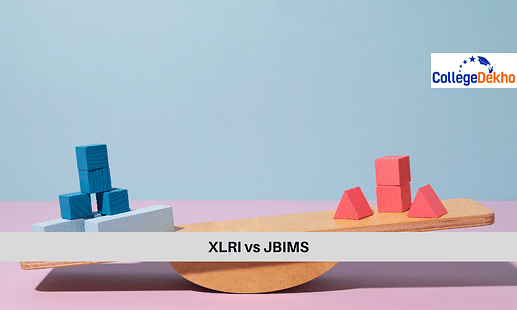
XLRI vs JBIMS: Both XLRI and JBIMS are the top of the line with a very good alumni network and are the most sought after by toppers in CAT, XAT or MAH MBA CET exams. One should consider themselves lucky to have a chance to pursue a career in one of these top colleges.
Set up in 1949, XLRI Jamshedpur has been ranked 8th for MBA in the NIRF Ranking 2023 and is approved by AICTE, AIU & GOI. The B-school offers a variety of degrees and other courses for students in business management or various other disciplines.
Jamnalal Bajaj Institute of Management Studies (commonly known as JBIMS), is a constituent department of the University of Mumbai. It was founded in 1965, and according to the Indian Institutional Ranking Framework (IIRF 2023), it is ranked 10th in the "Management" category. With a solid academic reputation, improved research facilities, increasing international engagement, and a robust alumni network,
JBIMS Mumbai
is a top business school in India. The college provides a wide range of academic degrees, such as the MBA, MFin, and MMS. It also has a solid track record of placements. Let us now explore further the major
differences between XLRI and JBIMS
.
Also Read:
XLRI Jamshedpur Selection Criteria 2023
XLRI vs JBIMS: Highlights
Before moving further, let us have a look at the table given below giving details about the XLRI vs JBIMS.
Particulars | XLRI | JBIMS |
|---|---|---|
Establishment Year | Ownership Type | 1949 | Private College | 1965 | Private |
Course Duration | 2 years | 2 years |
Campus Location | Jamshedpur, Delhi | Mumbai |
Affiliated to | AICTE | |
Rankings 2023 |
| 10 by IIRF |
Courses Offered | PGDM | MMS, MSc, MBA |
Accepted Entrance Exams | XAT | |
College Fees | INR 20 lPA to INR 23.6 LPA | INR 6.01 LPA to INR 7 LPA |
Average Salary Package | INR 32 LPA to INR 35 LPA | INR 27,63 LPA to INR 30 LPA |
Highest Salary Package | INR 40 LPA | INR 42 LPA |
Also Read: Compare XLRI vs FMS: Which B-School is Better?
XLRI vs JBIMS: Selection Process
Moving on, here's how the selection process for MBA at XLRI and JBIMS differ:MBA Selection Process at XLRI Jamshedpur
XLRI conducts its MBA admissions through the Xavier Aptitude Test (XAT), which is a national-level entrance exam. The selection process for XLRI generally includes the following steps:
a. XAT Exam: Candidates need to appear for the XAT exam, which assesses their aptitude in areas like English language skills, mathematics, reasoning, and general awareness.
b. Shortlisting: Based on the XAT scores, XLRI shortlists candidates for the next round of the selection process.
c. Group Discussion (GD) or Writing Ability Test (WAT): Shortlisted candidates are invited for GD or WAT, where they are assessed on their communication skills and ability to express their thoughts clearly.
d. Personal Interview (PI): After the GD/WAT, candidates go through a personal interview round to evaluate their personality, academic background, work experience (if any), and suitability for the program.
MBA Selection Process at JBIMS Mumbai
JBIMS, located in Mumbai, typically conducts its admissions through the MAH MBA CET conducted by the Government of Maharashtra. The selection process for JBIMS generally involves the following steps:
a. MAH CET Exam: Candidates need to appear for the MAH CET exam, which is a state-level entrance exam conducted by the Directorate of Technical Education (DTE), Maharashtra.
b. Shortlisting: Based on the MAH CET scores , JBIMS shortlists candidates for the next round of the selection process.
c. Group Discussion (GD) and Personal Interview (PI): Shortlisted candidates are called for GD and PI rounds, where they are assessed on their communication skills, knowledge, and suitability for the program.
XLRI vs JBIMS: Placement Record
The table given below is giving the placement record of XLRI vs JBIMS for the year 2023. Let us have a look at the table for more information:
Particulars | XLRI | JBIMS |
|---|---|---|
Average Salary (in INR) | 22 LPA | 18 LPA |
Highest Salary (in INR) | 40 LPA | 32 LPA |
Top Recruiters | Google, Amazon, Microsoft, P&G | Morgan Stanley, Goldman Sachs, Tata Group |
XLRI vs JBIMS: ROI
The Return on Investment (ROI) of a management programme is an important aspect for students since it allows them to assess the financial advantages of studying a certain degree. In the context of management education, ROI refers to the worth of the degree in terms of pay growth and job options vs the cost of the programme. Let us compare the ROI of XLRI and JBIMS:
College | Fees (in INR) | Highest Package/Average | ROI |
|---|---|---|---|
XLRI | 20-25 Lakhs | 22-24 Lakhs | High |
JBIMS | 2-3 Lakhs | 19-21 Lakhs | Very High |
XLRI vs JBIMS: Which is Better?
After getting an idea of the differences between XLRI and JBIMS, it is also important to be able to choose between the two based on your preferences. While both institutes have a strong reputation for placements, there are some differences that make one better than the other.
Pros of XLRI
- One of the oldest and most esteemed business schools in India is called XLRI, and it is situated in Jamshedpur, Jharkhand.
- The Post Graduate Diploma in Business Management (PGDBM) and the Post Graduate Diploma in Human Resource Management (PGDHRM) are two of XLRI's most well-known two-year full-time postgraduate diploma programs.
- A specialized Placement Committee at XLRI collaborates closely with businesses to streamline hiring. With a strong placement program, the institute places a lot of students who receive employment offers.
- The recruiters at XLRI come from a wide range of industries, including consulting, finance, marketing, technology, and more. Numerous prestigious national and international businesses come to the campus to recruit.
- The average and highest salary packages at XLRI are competitive, and students frequently receive lucrative job offers. The average placement package fluctuates annually but is typically substantial.
- Academic rigour, excellent faculty, and a focus on ethical and socially responsible leadership are all hallmarks of XLRI. The vast and powerful alumni network of XLRI offers chances for networking and professional success.
Pros of JBIMS
- JBIMS has its registered office in Mumbai, India, and is affiliated with the University of Mumbai. It's an old school for business in India.
- The Institute is offering a full-time master of management studies program, together with other executive traineeships and part-time Executive Programmes.
- JBIMS is offering a two-year Full Time SMMS program with the University of Mumbai. In the corporate world, JBIMS has a strong industry connection and a good reputation.
- The institute has a dedicated Placement Cell that actively engages with recruitment companies.
- There is a great track record of placements at the JBIMS site, with dozens of firms frequenting it. However, the number of recruitments and sector diversity may be rather small in comparison with XLRI.
- The typical salaries in JBIMS are competitive, though they do not match the very high levels of remuneration that XLRI offers. But, in line with market conditions and student profiles, these precise figures vary year by year.
In comparing XLRI and JBIMS, it is important to take into account your personal preference, career objectives as well as the specific characteristics and strengths of each institution. The factors should also be taken into account, e.g. course curricula, faculty, industry connections, location, and alumni network. In the end, your aspirations, interests, and opportunities offered by each institution that aligns with your goals determine whether or not you will choose between XLRI and JBIMS. Before making any decision, it is advisable to thoroughly examine the program, campus culture, faculty expertise, and career prospects.
Written by Agrima Gaba
















Similar Articles
CMAT Normalization Process 2025: How Scores are Calculated?
CMAT Merit List 2025: Check Marks & NTA Score, Toppers, All India Rank (AIR)
MBA Colleges for Low Percentile/ Score in CMAT 2025
MBA Colleges for 300-320 Marks in CMAT 2025
List of MBA Colleges Accepting 60-70 Percentile in CMAT 2025
List of MBA Colleges Accepting 50-60 Percentile in CMAT 2025